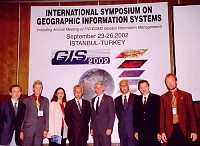-
The
German Council took over the administration of FIG January 1, 2003
- The Handover took place during the Intergeo 2002 in Frankfurt, 16
October, 2002
|
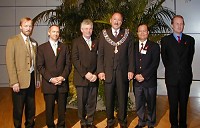
Gerhard Muggenhuber (on the left), Thomas Gollwitzer, Ralf Schroth,
Holger Magel, T.N. Wong and Andreas Drees. |
The FIG Council 2003-2006 started its work 1 January
2003. The new Council is chaired by Prof.
Holger Magel,
President of FIG (Germany). The members of the Council are Vice
President, Dr.-Ing.
Andreas Drees
(Germany), Vice President Dr.-Ing.
Ralf Schroth, Vice President
Bettina Petzold
(Germany) and Vice President
T.N. Wong (Hong Kong SAR, China). The remaining members of the
new Council are Congress Director
Thomas Gollwitzer (Germany) and Gerhard Muggenhuber
(Austria) as the representative of the Commission chairs. |
|
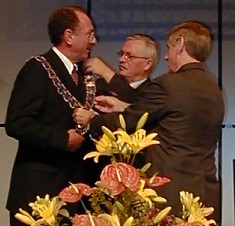
President Robert W. Foster gives the FIG chain to the
new President Prof. Holger Magel from Germany. Mr Foster is assisted by
Mr. Hagen Graeff, President of DVW. |
The handover ceremony between the US and
German Councils took place at opening of the Intergeo 2002 in Frankfurt,
Germany 16 October 2002. The biggest tradeshow on surveying business
attracted more than 15,000 visitors and the exhibition space was bigger
than ever exceeding 10,000 square metres (net). The conference and
opening ceremony attracted abut 700 delegates and invited guests.
The handover ceremony included performances of the Band of US Army and
cheerleaders from the Frankfurt Galaxy.
Read more about the
handover with picture gallery
on the FIG web site. |
Working Group 3 of FIG Commission 3 - Spatial Information Management - has
finalised its report
Land Information Management for Sustainable Development of Cities - Best
Practice Guidelines in City-wide Land Information Management which
is now available on the FIG web site. The report was officially launched
at the FIG 2002 Congress in Washington, DC in April 2002. The report is an
FIG contribution to the UN-HABITAT Best Practices Database and of its
learning and technical co-operation tools with good practices, policies
and enabling legislation in LIM.
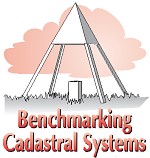 |
FIG Commission 7 Working Group (1998-2002) Reforming the Cadastre
has published its report on Benchmarking Cadastral Systems. The report
compiled and edited by Daniel Steudler and Jürg Kaufmann
includes contributions from 9 case studies from different countries. The
report was launched at the FIG General Assembly in Washington, DC in
April 2002. The report is available on the FIG web site as .pdf-file
(429 KB). Hard copies can be asked from the FIG Office. |
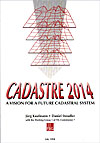 |
Cadastre 2014 - A Vision for a Future Cadastral System was first
published by FIG Commission 7 in 1998. The report written by
Jürg Kaufmann and Daniel Steudler with the Working Group
1 of FIG Commission 7 has now got its second edition and is available
from the FIG Office. The second edition was made possible by the support
of Leica Geosystems Ltd., a corporate member of FIG. Requests for the
report should be made to the FIG Office, email:
fig@fig.net.
The report is also available on web:
http://www.swisstopo.ch/fig-wg71/cad2014/cad2014/index.htm |
-
FIG Multilingual Technical Dictionary
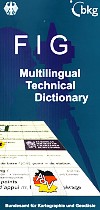 |
The FIG
Multilingual Dictionary can now be ordered via
Internet.
Already 10 revised editions have been published and 5 volumes are under
preparation. The Multilingual Dictionary is a result of work carried out
by the FIG Multi-Lingual Dictionary Board - a permanent institution of
FIG - for many years. The responsible organisation for editing is
Bundesamt für Kartographie und Geodäsie in Germany. The terms and
definitions as used in surveying and mapping are published in German
with equivalent technical terms in English and French. You can obtain
the volumes or to get more information from the Bundesamt für
Kartographie und Geodäsie, Aussenstelle Leipzig, Karl-Rothe-Strasse
10-14 D-04105 Leipzig, Germany, Tel. + 49 341 5634 - 330, Mrs. Kollenda,
fax + 49 341 56 34 - 415, email:
kollenda@leipzig.ifag.de
or from the web site:
http://www.ifag.de/Kartographie/Shop/index.html. |
-
The 2nd International Conference on Engineering Surveying – INGEO 2002
 |
The 2nd
International Conference of Engineering Surveying INGEO 2002 was
held in November 11–13, 2002 in the Congress Centrum of Slovak Savings
Bank in Bratislava. The conference was organised by the Department of
Surveying (DS) of the Faculty of Civil Engineering (FCE) of the Slovak
University of Technology (SUT) in Bratislava under the auspices of the
Dean of the FCE SUT Bratislava, Prof.
Dušan Petráš, PhD. |
The co-operation bodies of the conference were: FIG Commission 6 WG
6.2 – Engineering Surveys for Industry and Research; the Chamber of
Surveyors and Cartographers and the Slovak Union of Surveyors.
Specialists from the 9 various countries in the world, who work at
universities, research centres, in geodetic and building organizations
as well as in industry, have participated in proceedings. Total number
of participants was 76, out of which 36 participants were from foreign
countries and 40 participants from Slovak Republic.
Proceedings of the 2nd International Conference of Engineering
Surveying was aimed at a discussion about actual problems of engineering
surveying, about conclusion of knowledge and results, which were
acquired by the using of new modern technologies.
-
The Second International Symposium in Surveying (Education and
Professionalism) at the University of Puerto Rico in
Mayagüez, October 3-5,
2002
|

FIG representatives at the Symposium in Mayagüez: Prof.
John Parker (left), President Robert Foster, Prof. Stig Enemark and
Prof. Pedro Cavero. |
The Second International Symposium in Surveying
(Education and Professionalism) was organised at
the University of Puerto Rico in Mayagüez October
3-5, 2002. With the participation over 150 people
from several countries including USA,
Latin-America, and Europe, the conference was declared a success by
Mr. Robert W. Foster, President of FIG.
After an
opening address by
Mr. Foster, 18 technical presentations followed in the topics of
education, research and professional practice. A panel composed of
officials from different participating institutions and a student
debated motions and resolutions on Saturday. The Assembly of over a
hundred participants approved the
following motions
and resolutions October 5, 2002.
More
pictures from the Symposium.
|
-
GIS 2002 and Commission 3 Annual Meeting in Istanbul,
23-26 September 2002
|
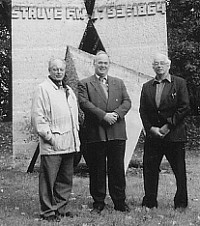
Prof. Jüri Randjärv, Jan de Graeve and Jim Smith at the Struve
monument outside Tartu Observatory. |
From 25 to 28 September 2002 the Association of Estonian
Surveyors, Estonian Land Board, Estonian Agricultural University and
Tartu University held a conference in Tallinn and Tartu on “Struve Arc
150”. 50 delegates from 10 countries attended- namely Norway, Sweden,
Finland, Russia, Estonia, Latvia, Lithuania, Belarus, Ukraine, Moldova,
Belgium and UK. Essentially it was commemorating the 150th anniversary
of the completion of the Struve Geodetic Arc that ran from near North
Cape in Norway to the Black Sea, but was an ideal opportunity to discuss
the arc in detail and to progress the efforts of the International
Institution for the History of Surveying & Measurement to have selected
points in each country recognised by UNESCO as a World Heritage
Monument. |
13 of the 15 technical papers were published in a special
booklet. In addition to the technical presentations the group visited the
remaining Struve survey stations marking the terminals of the Simuna
baseline and the starting point of the whole arc in Tartu (formerly
Dorpat) observatory. At the latter point the Rector of Tartu University,
Professor
Jaak Aaviksoo, unveiled a special plaque at the point set by Struve
on the meridian through the observatory. Four resolutions were passed, see
attached report.
-
Commission 7 Annual Meeting and Symposium
on Land Re-distribution in
Southern Africa, Pretoria, South Africa, November 4-9 2002
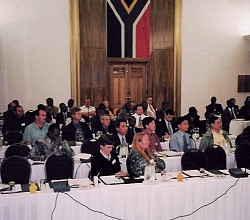 |
FIG Commission 7 Annual Meeting was
held in Pretoria, November 2002. This two
day seminar focused on land redistribution in
southern Africa
and was held in conjunction to the annual meeting of Commission 7.
This seminar
was part of Working Group 2 on ‘instruments for land
distribution’, chaired by Mikko Uimonen, and is included in the
Commission 7 Work Plan 2002-2006.
|
|

New chairs were elected to the ten technical Commissions at the
General Assembly in Washington, DC. |
At the FIG General Assembly Association four new member
associations were adopted: Association des Géomètres et Topographes du
Burkina (AGT-B), Asociación de Agrimensores del Uruguay (AAU),
Association of Authorised Land Surveyors Malaysia and Ordré National des
Géomètres du Cameroun (OGEC). In addition Nepal and Mexico joined as
affiliate members. |
The FIG Working Week 2007 was admitted to Hong Kong, China and the
Working Week 2003 that was planned to be held in Israel was postponed to
year 2009. The venue for Working Week 2003 will be confirmed by the
Council in June 2002.
Mr. T. N. Wong from Hong Kong, China was elected as a Vice
President of FIG for 2003-2006. He is the first Vice President that is
directly elected by the General Assembly following the new statutes and will
be a member of the German lead Council. The 10 FIG technical Commissions got
new officers who started their work at the end of the Congress. The new work
plans will be published on this site within short.
Memoranda of Understanding were adopted with UN-FAO, UN-HABITAT, ISPRS,
ICA and IFHP.
The FIG Foundation managed to collect almost US$ 50,000 in conjunction to
the Congress which allows to give the first grants before the end of this
year.
The
minutes with all appendices are now available on this site.
-
FIG Congress 2002 in Washington, D.C. April 19-26, 2002 attracted almost
4,000 surveyors from almost 90 countries - in the FIG programme more than
450 papers were presented in more than 110 sessions
|
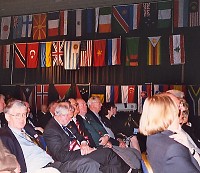
The Opening ceremony of the FIG Congress in Washington gathered a full
house. |
The XXII FIG International Congress was held in
Washington, D.C. USA April 19-26 2002. The Congress attracted almost
4,000 participants from almost 90 countries. The technical programme
included the FIG technical programme with more than 450 presentations in
more than 110 sessions. In addition in the domestic programme almost 160
papers were presented. Further there were several workshops organised by
ACSM and ASPRS. The report from the
conference with pictures.
|
The FIG Congress Prize 2002 was given to Mr George Oner
Ogalo from Kenya for his presentation "GPS
in Cadastres: A Case Study of Kenya".
The
papers from the FIG Technical Programme are now available on this web
site. You are also able to view the
extended abstracts. Proceedings (DC-Rom and extended abstract) can be
ordered from the FIG Office, price US$ 50 including postage.
The
FIG Standards Network (Joint Commission Working Group WG1.1 under
Commission 1) is continuing the work of an FIG Task Force which was
established in 1998 in response to concerns from the Commissions, the
Council and the General Assembly that standards were becoming increasingly
important in the work of surveyors, and that the issue was not being
addressed sufficiently by FIG.
The Network's terms of reference are as follows:
- Building and maintaining relations with the secretariats of
standardisation bodies;
- Proposing priorities on FIG's standardisation activities, including
advising the Council on priorities for spending;
- Setting up necessary Liaison relationships with standardisation
bodies;
- Ensuring that lead contacts to Technical Committees etc are in
place;
- Maintaining an information flow on standardisation to FIG members,
including through the FIG website and FIG Bulletin, and more directly to
relevant Commission Officers;
- Maintaining the Guide
on Standardisation, and related material on the FIG website;
- Working with other NGOs, within the framework of the MOUs signed by
the Council; and
- Advising FIG's officers and members on standardisation activities as
necessary.
The Network sees itself as at the hub of FIG standardisation activity,
making the necessary linkages and providing the necessary advice to
commissions and others.
|































